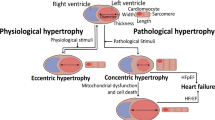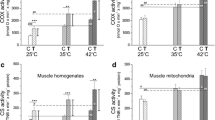Abstract
Endurance exercise is widely assumed to improve cardiac function in humans. This project has determined cardiac function following endurance exercise for 6 (n = 30) or 12 (n = 25) weeks in male Wistar rats (8 weeks old). The exercise protocol was 30 min/day at 0.8 km/h for 5 days/week with an endurance test on the 6th day by running at 1.2 km/h until exhaustion. Exercise endurance increased by 318% after 6 weeks and 609% after 12 weeks. Heart weight/kg body weight increased by 10.2% after 6 weeks and 24.1% after 12 weeks. Echocardiography after 12 weeks showed increases in left ventricular internal diameter in diastole (6.39 ± 0.32 to 7.90 ± 0.17 mm), systolic volume (49 ± 7 to 83 ± 11 μl) and cardiac output (75 ± 3 to 107 ± 8 ml/min) but not left wall thickness in diastole (1.74 ± 0.07 to 1.80 ± 0.06 mm). Isolated Langendorff hearts from trained rats displayed decreased left ventricular myocardial stiffness (22 ± 1.1 to 19.1 ± 0.3) and reduced purine efflux during pacing-induced workload increases. 31P-NMR spectroscopy in isolated hearts from trained rats showed decreased PCr and PCr/ATP ratios with increased creatine, AMP and ADP concentrations. Thus, this endurance exercise protocol resulted in physiological hypertrophy while maintaining or improving cardiac function. (Mol Cell Biochem 251: 51–59, 2003)
Similar content being viewed by others
References
Fagard R: Athlete's heart: A meta-analysis of the echocardiographic experience. Int J Sports Med 17: S140-S144, 1996
Douglas P, O'Toole M, Katz S, Ginsburg G, Hiller D, Laird R: Left ventricular hypertrophy in athletes. Am J Cardiol 80: 1384-1388, 1997.
Thomas D, Zimmerman S, Hansen T, Martin D, McMormick R: Collagen gene expression in rat left ventricle: Interactive effect of age and exercise training. J Appl Physiol 89: 1462-1468, 2000.
Moore R: Cellular adaptations of the heart muscle to exercise training. Ann Med 30(suppl 1): 46-53, 1998
Brown L, Duce B, Miric G, Sernia C: Reversal of cardiac fibrosis in deoxycorticosterone acetate-salt hypertensive rats by inhibition of the renin-angiotensin system. J Am Soc Nephrol 10: S143-S148, 1999
Brown L, Fenning A, Shek A, Burstow D: Reversal of cardiovascular remodelling with candesartan. J Renin-angiotensin-aldosterone Syst 2(suppl 1): S141-S147, 2001.
Doggrell S, Brown L: Rat models of hypertension, cardiac hypertrophy and failure. Cardiovasc Res 39: 89-105, 1998.
Aeschbacher B, Hutter D, Fuhrer J, Weidmann, P, Delacretaz E, Allemann Y: Diastolic dysfunction precedes myocardial hypertrophy in the development of hypertension. Am J Hyper 14: 106-113, 2001.
Jin H, Yang R, Li W, Lu H, Ryan A, Ogasawara A, Peborgh J, Paoni N: Effects of exercise training on cardiac function, gene expression, and apoptosis in rats. Am J Physiol 279: H2994-H3002, 2000.
Woodiwiss AJ, Norton GR: Exercise-induced cardiac hypertrophy is associated with an increased myocardial compliance. J Appl Physiol 78: 1303-1311, 1995.
Woodiwiss A, Oosthuyse T, Norton G: Reduced cardiac stiffness following exercise is associated with preserved myocardial collagen characteristics in the rat. Eur J Appl Physiol 78: 148-154, 1998.
Yamashita N, Hoshida S, Otsu K, Asahi M, Kuzuya T, Hori M: Exercise provides direct biphasic cardioprotection via manganese superoxide dismutase activation. J Exp Med 189: 1699-1706, 1999.
Lebine SN, Kinasewitz GT: Exercise conditioning increases rat myocardial calcium uptake. J Appl Physiol 60: 1673-1679, 1986
Kingwell BA: Nitric oxide as a metabolic regulator during exercise: Effects of training in health and disease. Clin Exp Pharmacol Physiol 27: 239-250, 2000
Stuewe SR, Gwirtz PA, Agrawal N, Mallet RT: Exercise training enhances glycolytic and oxidative enzymes in canine ventricular myocardium. J Mol Cell Cardiol 32: 903-913, 2000
Spencer RG, Buttrick PM, Ingwall JS: Function and bioenergetics in isolated perfused trained rat hearts. Am J Physiol 272: H409-H417, 1997
Abete P, Calabrese C, Ferrara N, Cioppa A, Pisanelli P, Cacciatore F, Longobardi G, Napoli C, Rengo F: Exercise training restores ischemic preconditioning in the aging heart. J Am Coll Cardiol 36: 643-650, 2000
Claessens P, Claessens C, Claessens M, Claessens M, Claessens J: Supernormal left ventricular diastolic function in triathletes. Tex Heart Inst J 28: 102-110, 2001
Dwyer D, Browning J: Endurance training in Wistar rats decreases receptor sensitivity to a serotonin agonist. Acta Physiol Scand 170: 211-216, 2000
Brown L, Fenning A, Chan V, Loch D, Wilson K, Anderson B, Burstow D: Echocardiographic assessment of cardiac structure and function in rats. Heart Lung Circ 11: 167-173, 2002
Litwin SE, Katz SE, Morgan JP, Douglas PS: Serial echocardiographic assessment of left ventricular geometry and function after large myocardial infarction in the rat. Circulation 89: 345-354, 1994
Harrison GJ, Willis RJ, Headrick JP: Extracellular adenosine levels and cellular energy metabolism in ischemically preconditioned rat heart. Cardiovasc Res 40: 74-87, 1998.
Wisloff U, Helgerud J, Kemi OJ, Ellingsen O: Intensity-controlled treadmill running in rats: Vo2max and cardiac hypertrophy. Am J Physiol 280: H1301-H1310, 2001
Wisloff U, Loennechen JP, Falck G, Beisvag V, Currie S, Smith G, Ellingsen Ø: Increased contractility and calcium sensitivity in cardiac myocytes isolated from endurance trained rats. Cardiovasc Res 50: 495-508, 2001
Rodnick KJ, Reaven GM, Smaldone PG, Riedy M, Zelis R: Variations in running activity and enzymatic adaptations in voluntary running rats. J Apply Physiol 66: 1250-1257, 1989
Guazzi M, Brenner DA, Apstein CS, Saupe KW: Exercise intolerance in rats with hypertensive heart disease is associated with impaired diastolic relaxation. Hypertension 37: 204-208, 2001
Claessens C, Claessens P, Bloemen H, Claessens M, Verbanck M, Fagard R, Claessens J: Structural heart adaptations in triathletes. Acta Cardiol 54: 317-325, 1999
Jonsdottir I, Lungersten L, Johansson C, Wennmalm A, Thoren P, Hoffmann P: Increase in nitric oxide formation after chronic voluntary exercise in spontaneously hypertensive rats. Acta Physiol Scand 162: 149-153, 1998
MacCarthy PA, Shah AM: The role of nitric oxide in the regulation of myocardial relaxation and diastolic function. Asia Pacific Heart J 7: 29-37, 1998
Neubauer S, Horn M, Pabst T, Harre K, Stromer H, Bertsch G, Sandstede J, Ertl G, Hahn D, Kochsiek K: Cardiac high-energy phosphate metabolism in patients with aortic valve disease assessed by 31P-magnetic resonance spectroscopy. J Invest Med 45: 453-62, 1997
Conway MA, Allis J, Ouwerkerk R, Niioka T, Rajagopalan B, Radda GK: Detection of low phosphocreatine to ATP ratio in failing hypertrophied human myocardium by 31P magnetic resonance spectroscopy. Lancet 338: 973-6, 1991
Zhang J, Merkle H, Hendrich K, Garwood M, From AH, Ugurbil K, Bache RJ: Bioenergetic abnormalities associated with severe ventricular hypertrophy. J Clin Invest 92: 993-1003, 1993
Zhang J, Toher C, Erhard M, Zhang Y, Ugurbil K, Bache RJ, Lange T, Homans DC: Relationships between myocardial bioenergetics and left ventricular function in hearts with volume-overloaded hypertrophy. Circulation 96: 334-343, 1997
O'Donnell MJ, Narayan P, Bailey MQ, Abduljalil AM, Altschuld RA, McCune SA, Robitaille PM: 31P-NMR analysis of congestive heart failure in the SHHF/Mcc-facp rat heart: J Mol Cell Cardiol 30: 235-241, 1998
Coates AJS: Exercise training in heart failure. Curr Control Trials Cardiovasc Med 1: 155-160, 2000
Belardinelli R, Georgiou D, Cianci G, Purcaro A: Randomized, controlled trial of long-term moderate exercise training in chronic heart failure. Circulation 99: 1173-1182, 1999
Shephard RJ, Balady GJ: Exercise as cardiovascular therapy. Circulation 99: 963-972, 1999
Willenheimer R, Rydverg E, Cline C, Broms K, Hillberger B, Oberg L, Erhardt L: Effects on quality of life, symptoms and daily activity 6 months after termination of an exercise training programme in heart failure. Int J Cardiol 77: 25-31, 2001
Author information
Authors and Affiliations
Rights and permissions
About this article
Cite this article
Fenning, A., Harrison, G., Dwyer, D. et al. Cardiac adaptation to endurance exercise in rats. Mol Cell Biochem 251, 51–59 (2003). https://doi.org/10.1023/A:1025465412329
Issue Date:
DOI: https://doi.org/10.1023/A:1025465412329




